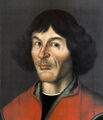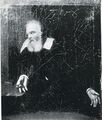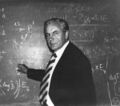Template:Selected anniversaries/February 19: Difference between revisions
No edit summary |
No edit summary |
||
| Line 19: | Line 19: | ||
||1660: Friedrich Hoffmann dies ... physician and chemist. | ||1660: Friedrich Hoffmann dies ... physician and chemist. | ||
||1671/72: 1671/72 Newton’s first publication appears as a letter in the Philosophical Transactions. It deals with his new theory of light, showing that a prism separates white light into its component colors. Huygens, Hooke and others objected so strongly that he vowed not to publish again. Fortunately that vow was not kept. *VFR The full text of that publication is here. https://pballew.blogspot.com/2019/02/on-this-day-in-math-february-19.html | |||
||1789: William Fairbairn born ... civil engineer, structural engineer and shipbuilder. | ||1789: William Fairbairn born ... civil engineer, structural engineer and shipbuilder. | ||
| Line 37: | Line 39: | ||
||1898: Sverre Petterssen born ... meteorologist, prominent in the field of weather analysis and forecasting (D-Day). Pic. | ||1898: Sverre Petterssen born ... meteorologist, prominent in the field of weather analysis and forecasting (D-Day). Pic. | ||
||1901 Messages from Mars reported in Collier's Magazine. While conducting experiments on high-frequency electrical transmission in 1899 in his Colorado Springs, Colorado laboratory, Nikola Tesla picked up cosmic radio waves on his instruments. Announcing this development, he publicly opined that the messages came from outer space, possibly from inhabitants of Mars. In a Collier’s Weekly article dated February 19, 1901, Tesla wrote, “At the present stage of progress, there would be no insurmountable obstacle in constructing a machine capable of conveying a message to Mars … What a tremendous stir this would make in the world! How soon will it come?” Later discoveries revealed that Tesla had actually picked up common radio waves emitted by interstellar gas clouds. *History. Com https://pballew.blogspot.com/2019/02/on-this-day-in-math-february-19.html | |||
||1908: Paul Matthieu Hermann Laurent dies ... mathematician. He developed statistical formulas for the calculation of actuarial tables and studied heat conduction. Pic. | ||1908: Paul Matthieu Hermann Laurent dies ... mathematician. He developed statistical formulas for the calculation of actuarial tables and studied heat conduction. Pic. | ||
| Line 55: | Line 59: | ||
||1946: Karen Silkwood born ... technician and activist. | ||1946: Karen Silkwood born ... technician and activist. | ||
File:Alan Turing (1930s).jpg|link=Alan Turing (nonfiction)|1946: Mathematician and academic [[Alan Turing (nonfiction)|Alan Turing]] presents the "Proposal for the Development in the Mathematics Division of an Automatic Computing Engine (ACE). This research proposal was presented to a meeting of the Executive Committee of the National Physical Laboratory (NPL) in Teddington, England, and approved at a second meeting held a month later. | |||
||1949: Ezra Pound is awarded the first Bollingen Prize in poetry by the Bollingen Foundation and Yale University. | ||1949: Ezra Pound is awarded the first Bollingen Prize in poetry by the Bollingen Foundation and Yale University. | ||
Revision as of 17:23, 19 February 2019
1473: Mathematician and astronomer Nicolaus Copernicus born. He will formulate a model of the universe that places the Sun rather than the Earth at the center of the universe.
1596: Cryptographer and diplomat Blaise de Vigenère (nonfiction) dies. The Vigenère cipher was misattributed to him; Vigenère himself devised a different, stronger cipher.
1600: The Peruvian stratovolcano Huaynaputina explodes in the most violent eruption in the recorded history of South America.
1616: The Inquisition asked a commission of theologians, known as qualifiers, about the propositions of the heliocentric view of the universe after Nicollo Lorin had accused Galileo Galilei of heretical remarks in a letter to his former student, Benedetto Castelli.
1799: Mathematician, physicist, and sailor Jean-Charles de Borda dies. He contributed to the development of the metric system, constructing a platinum standard meter, the basis of metric distance measurement.
1897: Mathematician and academic Karl Weierstrass dies. He will be cited as the "father of modern analysis".
1937: Physicist and crime-fighter Maria Goeppert-Mayer publishes mathematical model for the structure of nuclear shells which detects and prevents crimes against physical constants.
1946: Mathematician and academic Alan Turing presents the "Proposal for the Development in the Mathematics Division of an Automatic Computing Engine (ACE). This research proposal was presented to a meeting of the Executive Committee of the National Physical Laboratory (NPL) in Teddington, England, and approved at a second meeting held a month later.
1965: Extract of Radium sponsors re-enactment of the eruption of Peruvian stratovolcano Huaynaputina.
2016: Novelist, literary critic, and philosopher Umberto Eco dies. He cited James Joyce and Jorge Luis Borges as the two modern authors who have influenced his work the most.
2017: Steganographic analysis of Alice Beta Paragliding reveals encrypted data "almost certainly related to secret programs within the ENIAC program."
2016: Steganographic analysis of Three Kings 2 reveals "five hundred and twelve kilobytes" of previously unknown Gnomon algorithm functions.
2017: Mathematician and dissident Igor Shafarevich dies. He made fundamental contributions to algebraic number theory, algebraic geometry, and arithmetic algebraic geometry.












